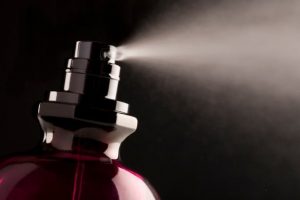 The Dangers of Febreze
The Dangers of Febreze
Febreze is classified as an air freshener, created by Proctor & Gamble. It reports to work by “trapping” odor molecules in a donut-shaped chemical.
The first thing that is really important to understand: the product does not remove odor molecules and it doesn’t clean the item it comes into contact with.
The odor molecules are still there. Your nose just can’t perceive them because you smell the chemical product instead.
For more related information on how EZ Breathe can help with smells and odors.
That alone should be your first warning. We know inhalation of any chemicals is dangerous, and several of its ingredients listed below are known to irritate the lungs… but this is a chemical whose entire purpose is to be inhaled!
The Natural Resources Defense Council studied the effects of air fresheners, discovering that they currently undergo no safety testing. The results were disturbing, because they revealed high levels of phthalates, which are known to be especially harmful to children. These chemicals were even present in sprays which were claimed to be “All-Natural” and “unscented”. Phthalates were not disclosed in the list of ingredients for any of the products. “Phthalates are hormone-disrupting chemicals that can be particularly dangerous for young children and unborn babies. Exposure to phthalates can affect testosterone levels and lead to reproductive abnormalities, including abnormal genitalia and reduced sperm production. The State of California notes that five types of phthalates — including one that we found in air freshener products — are ‘known to cause birth defects or reproductive harm.’” — Natural Resources Defense Council
1,4- Dichlorobenzene is a chemical that is found in the blood of 96% of Americans. It has been linked to lung damage, is a known carcinogen, and it is an E.P.A. registered pesticide. Studies found it to increase rates of asthma. It can be found in the majority of air fresheners, toilet deodorizers, and mothballs. It works by attacking the receptors in the nose, and thus eliminating the sense of smell. This is how the new generation of air fresheners actually “freshen”. This chemical was introduced into the American market with the Febreze product from Proctor & Gamble. The new generation of air fresheners that were inspired by the success of Febreze are literally using chemical warfare to destroy their customers’ sense of smell. That lack of smell is where the illusion of freshness comes from. The user only smells these air fresheners for about a minute after they have been sprayed, and then the nose cannot smell most fragrances anymore. This is not a normal adjustment to odors, anymore than a loss of one of the other four senses. The process is the equivalent of using a chemical blinding agent to escape the unpleasantness of a bright light; when that chemical is known to be both poisonous and carcinogenic. By design, the freshening chemical causes damage to the mucous membrane, which is claimed to be temporary. However, no long-term studies have ever been done to test the effects of chronic exposure. It is important to remember that anything inhaled is immediately absorbed into the blood through the lungs relatively unchanged.
Unfortunately there is not much data being shared on Febreze and their many products, but the Environmental Working Group (EWG) did conduct a test for the ingredients of one of their products, Febreze Air Effects.
Shockingly, P&G only disclosed THREE ingredients in this product, but the EWG…they found 87 chemicals in total!
Now this is just one Febreze product, but the fact that only 3 ingredients were disclosed and that so many undisclosed ingredients are dangerous, it’s safe to assume that their other air fresheners are just as dangerous.
Febreze Ingredients
Below you’ll find a list of just some of the 87 chemicals found by the EWG in Febreze Air Effects, listed in order of their toxicity to humans:
- BHT – Known as a neurotoxin, endocrine disruptor, immunotoxicity, non-reproductive organ system toxicity, skin eye and lung irritator
- Acetaldehyde – Known to cause cancer, toxic to reproduction and development, immunotoxin, non-reproductive organ system toxin, skin, eye and lung irritator
- “Fragrance” – One of the three ingredients actually disclosed, it’s a neurotoxin, immunotoxin and allergen
- Propylene Glycol – Causes cancer, allergies, toxic to immune system, accumulates in the system, non-reproductive organ system toxin, is classified with “enhanced skin absorption” and irritates the skin, eye and lung
- 1,3-Dichloro-2-propanol – Carcinogenic (causes cancer)
- Limonene – Allergen, immunotoxin and skin, eyes and lung irritator
- Methyl pyrrolidone – Toxin to reproduction and development, allergen and immunotoxin, non-reproductive organ system toxin and skin, eyes and lung irritator
- Alcohol denatured – Also disclosed in the ingredients of Febreze, it’s linked to cancer, developmental/reproductive toxicity, organ system toxicity and skin, eyes and lung irritator
- Butylphenyl methylpropion al – allergen, immunotoxin and and skin, eyes and lung irritator
- Ethyl acetate – linked to developmental/reproductive toxicity, neurotoxicity, organic system toxicity and and skin, eyes and lung irritator
- Geraniol – Linked to allergies, immunotoxicity, organi system toxicity and and skin, eyes and lung irritation
- Linalool – allergen, immunotoxin, and and skin, eyes and lung irritator
- Benzaldehyde – neurotoxin, and skin, eyes and lung irritator
- Diethylene glycol monoethyl ether – non-reproductive organ system toxicity
- Ethylhezanol – developmental and reproductive toxin and skin, eyes and lung irritator
- Hexyl cinnamal – allergen, immunotoxin and skin, eyes and lung irritator
- And way too many more…
You can find the EWG’s full report on the dangers of Febreze and other common cleaners here.
Removing Odors Naturally
Again, it’s important to understand that these types of products are not only dangerous to our health, but they aren’t actually cleaning the air or eliminating odor. They are just masking it…the bacteria and molecules are still hanging around, maybe even making you sick themselves.
If you really want to remove odors naturally there are two recommendations I have:
- Types of Houseplants That Clean the Air – In this article I’ll point out the best houseplants to use to freshen indoor air, as well as just how effective they really are.
- Removing Odor Naturally – Here I’ll show you how you can actually remove odors for all kinds of surfaces…safely, easily and naturally.
- ACTUALLY Purify the Air: Febreze doesn’t purify, but only masks odors. But essential oils can actually purify the air and eliminates odor.
Source: The Dangers of Febreze.







 The same force that causes hot air balloons to rise in to the sky is present in all of our homes. This “
The same force that causes hot air balloons to rise in to the sky is present in all of our homes. This “ Increased ventilation is an easy and effective way to control poor indoor air by bringing fresh indoor air into circulation. Especially because most heating systems do not bring fresh air into the home. Whole home ventilation systems not only create a path of escape for the myriad of pollutants trapped inside our homes, but also make room for better air to be introduced. Solution by dilution. Increase the amount of fresh air entering the building envelope is an effective way to improve the quality of indoor air
Increased ventilation is an easy and effective way to control poor indoor air by bringing fresh indoor air into circulation. Especially because most heating systems do not bring fresh air into the home. Whole home ventilation systems not only create a path of escape for the myriad of pollutants trapped inside our homes, but also make room for better air to be introduced. Solution by dilution. Increase the amount of fresh air entering the building envelope is an effective way to improve the quality of indoor air











